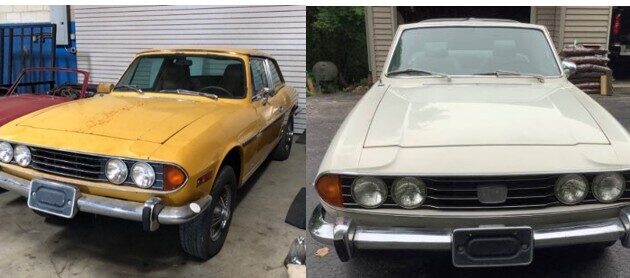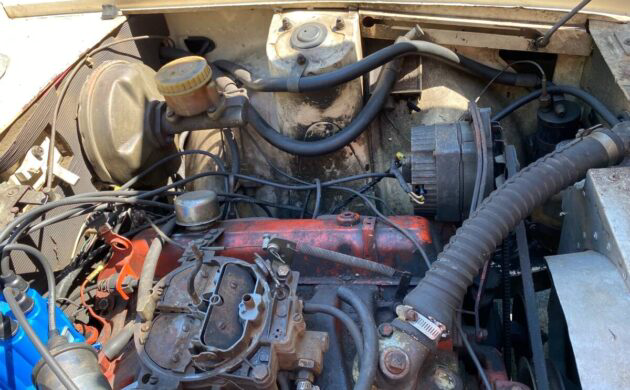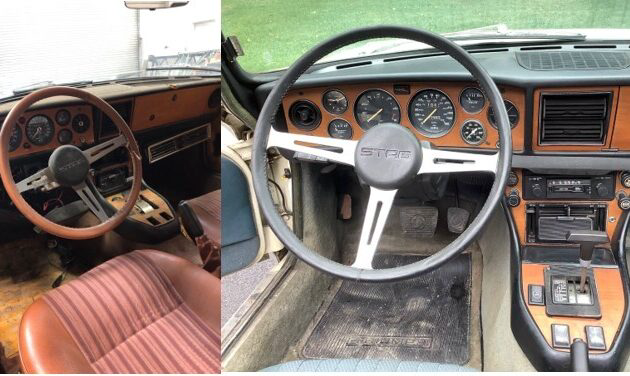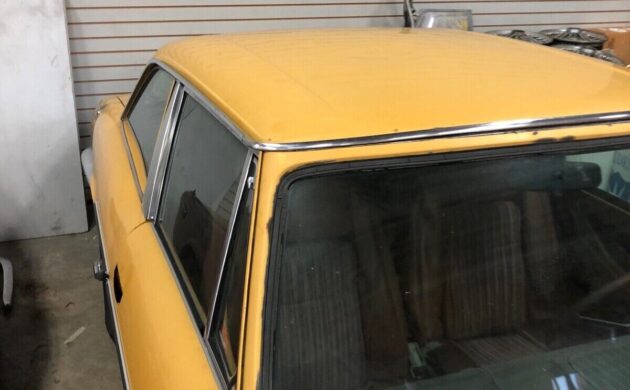Coincidentally, these two examples of Triumph’s luxury sport Stag arrived on the Barn Finds assignment list at the same time. What are the chances! Both are project cars: one has no motor and one has a Chevy 283 cu. in. V8. Which one would you tackle? Let us know below. The yellow car is a 1971 automatic here on eBay, looking for an opening bid of $2000. Its engine bay is empty and it’s located in Lakeside, California. The white car is here on craigslist, vintage 1973, running that SBC with a 350 automatic, at an asking price of $3200. This one is in La Crosse, Wisconsin, and the tip came from Pat L – thanks Pat! Both cars have their hard tops as well as a soft top; to meet American anti-roll standards, the cars were designed with a rollbar in the B-pillar position, braced to the windscreen frame. The ’71 is a Mk I; in early 1973, the Mk II was produced. Differences included reworked combustion chambers in the V8 motor, and slight alterations to gauges, bumpers, seats, exterior trim, and wheels.
Here’s the 283 V8 resting comfortably in the white ’73. We are not told whether it runs. Meanwhile, the yellow car offers a clean slate, with its empty engine bay. It’s not an accident that we see swaps and missing engines when it comes to Stags – the Triumph V8 was awful. The water pump was situated in the valley of the “V”, guaranteeing an unhappy experience on hot days. Then, to meet US emissions standards, twin carbs were used instead of fuel injection which degraded the power output. To boost power, Triumph’s engineers increased displacement, which wrecked the torque and shrank the block’s coolant passages, compounding overheating issues. Head studs were installed at two different angles, causing warpage. Speaking of heads, they were made of low-grade aluminum alloy and had a tendency to corrode. Timing chains were long and thin – missing a replacement interval courted disaster. All that said, the motors are not impossible to cope with given today’s technology, and there’s no question that a Stag with its original motor is worth more than one without.
The yellow Stag’s interior is on the left; the white one is on the right. The white car is tidier though neither is perfect. The ’70s was a time of ambitious use of electricity in cars: the Stag has power windows prone to failure. Fortunately, parts for Stags are still available, though it might take some persistence across different vendors to find what you need.
Each seller declares that rust on his car is nearly nil; the yellow car does have surface rust on the bonnet. A close examination of the yellow car’s photos shows that the panel fit is not great. The white car has clean, tight gaps, and it is a Mk II. It does have a motor, albeit the wrong one, and of questionable competency. I know which I would pick; what do you think?















Great write up Michelle. I’m not very familiar with these cars, so I’m curious how increasing engine displacement “wrecks torque” in a Triumph V8.
So Triumph started with a 2.5 liter V8 that the engineering dept created by twinning an existing inline four cylinder. When carbureted for the US, that engine didn’t make enough power. Triumph’s solution was to create an over-square architecture by enlarging the bore, bringing displacement to 3.0 l, but it didn’t compensate in any way to maintain torque at the low end. Stroke remained the same, with the result that the engine gained horsepower but moved torque up the rpm band. Down low, you need to shift to get it to move. Triumph could have used the Rover V8, but wanted to prove it could engineer its own V8…. which I guess it didn’t. Specs I found on the Rover were 155 hp/198 lb-ft @2500 rpm; for the TV8, 165 hp/170 lb-ft @3500 rpm. See here for more horror stories on the TV8:
https://driving.ca/auto-news/entertainment/triumphs-v8-the-worst-engine-ever-made#:~:text=Other%20issues%20included%20main%20bearings,the%20valves%20and%20pistons%20too.
https://nihilistnotes.blogspot.com/search?q=Unique
Yes, that’s correct. The decision not to use the Rover V8 was on no better basis than the Triumph engineers not wanting to although, given the sales then projected for the Stag, the decision would have had to have been taken early to ensure Rover had the capacity to increase production. The best solution would have been to adopt the Daimler V8 which Jaguar discontinued. Easily it could have been produced in 2.8 liter form to take advantage of continental tax rates and was a robust, reliable thing which sounded just as good as the Triumph unit, the exhaust note of which was one thing for which it was never criticized. There were seven fundamental problems with the Stag V8 and while some can now be solved, others can be only monitored and managed. However, many are prepared to do exactly that because a well-sorted Stag really can seduce.
It’s odd that Triumph intended to build a 2.5 liter version of the V8, considering that he smallest displacement version of the four cylinder it was based on that reached production was a 1.7 liter, and the smallest version meant for production was 1.5 liters.
I will pick the bust bus ticket ain’t no Triump no triumphs phs
That’s a new perspective-two of the same for sale, pros and cons of each..
Something about the exterior design just looked as though it wasn’t drawn out all at once, like it was a gangly preteen version of a Spitfire growing up. And interesting too to find out why that V8 was so anemic.
Good stuff, Michelle.
Great write up Michelle.
Thanks! I like the compare/contrast format, plus it’s a good way to knock off a couple cars in one stroke, ha!
Did you get paid for two write ups?😀
Buy both of these, and then send out invitations to a Stag party, which actually consists of having your friends help push the cars off of the transporter and into your garage…beer following the event.
Ha ha ha it’s a joke ? Right? Really about $1000-1500 tops. Then find a modern engine & tranny, and still another wannabe. Only if you Love the car and have Thousands to throw, Igor invest.
While not horrible cars to drive, and quite nice when sorted, my first boss in the trade had one, and I got stuck ferrying his wife around in it far too much…that he was a complete slimeball has me now hating these lol.
I obtained a 73 Stag with a bad motor. Replaced it with a Ford 289 and 4 speed overdrive transmission. Power and weight was comparable to an early Mustang. Fully independent suspension all around provided a smooth ride
It was a comfortable touring car.
I’d have the cheaper of the two and get busy with the welding gear. I always thought that a Stag fastback (like the GT6) would be a fab thing. Sorted Stag motor, 5-speed (getrag, maybe?), a wee bit lower would all make for a rather nice GT.